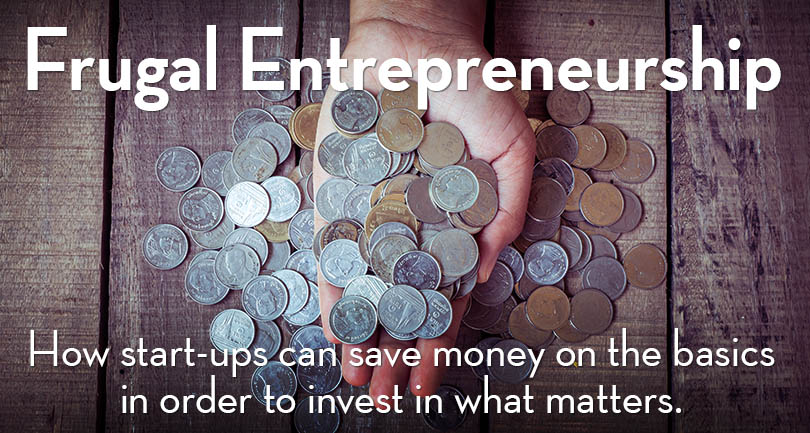
Time is Money
Everyone knows the saying “time is money.” In start-ups, I think the reverse is more relevant: money is time. Limited money is what determines the time available to complete a project. The burn rate is the ticking time bomb against which we race.
Successful start-ups need to spend money. There aren’t very many that can operate on air alone. Yet there are places I recognize as a good use of cash and other places where I’ll find ways to scrimp like Scrooge. Even as we spend thousands of dollars on an outside contractor’s expertise or hundreds for a piece of necessary software, I find ways to cut $20 or $50 where I think things aren’t necessary.
To my mind, spending thousands of dollars for something that is going to advance us toward launch is a good use of money. Spending $10 on something that is superfluous is a waste of money – and therefore of time. $10 here and there adds up quickly, so saving that money can help buy you a little more time. When you’re racing against the clock, a couple of extra days can make a big difference.
Cutting corners on the small stuff and reallocating for important expenses is nothing new to entrepreneurs. Yet technology makes that easier than ever in a lot of ways.
Frugal Entrepreneurship
A web search for “frugal entrepreneur” brings up plenty of hits, including (of course) a website called Frugal Entrepreneur, which has lots of resources, including freeware, advice for different types of entrepreneurs and also general business and human interest stories.
Even before the internet changed everything, Jay Conrad Levinson was telling entrepreneurs to use “guerrilla marketing” to find budget-friendly and innovative ways to get their stories out. The Guerrilla Marketing series – now more than 50 titles in all – is a go-to for frugal tips and now includes specific volumes for home-based businesses, retailing, negotiating and many more. The series also skews now toward online marketing, which of course has initiated a revolution for businesses seeking publicity. The double-edged sword here is that, while much online marketing is free and has a global reach, those same incredible advantages are available to our competitors. We’re in a global marketplace now, which is awesome, but it means we’re competing against the world, which is daunting.
This knowledge drives me even harder to find ways to compete against others who are in places where the cost of doing businesses isn’t as high as the West Coast, where I’m based.
Forget Fancy Furniture

Entrepreneur magazine a while back offered “7 Frugal Startup Tips from Millionaire Entrepreneurs,” which include some good advice. One tip was: forget the fancy furniture. I like the gritty, appearances-be-damned advice. But I also like a nice looking office. So I found a way to get the fancy furniture and pay next to nothing.
We got fairly impressive furniture at a crazy low price by going to a business liquidation auction. It was so cheap we ended up with more furniture than we could actually use. We had to sell some on Craigslist (at a profit). The best deal was our boardroom table. An identical table went at the beginning of the auction for $600. We waited around for six hours – I judged the value of the time in terms of money saved and worked late that night – and got the same table for $25. All together, we guesstimate we got about $10,000 in furniture and equipment for $1,400.
Our company has found a few other innovative and sometimes unexpected ways to save dimes and dollars.
We’ve been in a two-year development cycle for our gamified etail app, BidOkee. In that time, as the project has gone through the various progressions, our office has surged and retracted with contractors and freelancers. We have been lucky to find other businesses to fill marginal space for a few months here and a few weeks there. Between our staff and friends, who are mostly involved in one form of start-up or another, we’ve never had trouble filling vacant spaces.
The office, in a convenient (but not pretty) light industrial area, seems oddly laid out when you first walk in – there’s no reception, just a warren of small offices clustered on one end and a kitchen and boardroom on the other. This odd layout has proved practical, though, as we have been able to accommodate when one team grows and another shrinks. In the process, we have been able to recoup some of the rent that would have been effectively wasted during those periods when our core team was smallest. (I wonder if an AirBnB for temp office space might be some entrepreneur’s next big thing?)
Cooking & Cleaning Together

We are lucky to have an office with a kitchen. (Well, it’s a space with a sink and a couple of cupboards, to which we added a stove and refrigerator.) Whoever is in the office on a given week tosses cash into a pool and a designated pair makes a shopping trip. Everyone takes turns preparing the lunch. (Some are more imaginative and skilled than others.) However, we generally prepare very healthy meals, which always include a major salad. It might sound like an unwieldy proposition, herding people from different companies to participate, cook and clean up, but we have found it surprisingly successful.
At noon, the boardroom becomes a lunch room. Eclectic people from various companies socialize and talk about our projects. The lunch program is a cost-saver in a sense – we each save some cash and probably eat more healthfully – but it is a break that nevertheless does not interrupt the creative flow of the day and the synergies we produce have had some unintended positive benefits.
On Fridays, we all stop for 15 minutes and divide up the tasks of cleaning the kitchen, the offices, the floor, the washroom and whatever else needs attention. Our cleaning expenses are nil.
These are not major savings individually. But they add up to some money over time. And that is money that can be used to buy some time.

Eyal Lichtmann is CEO of BidOkee, an in-development app that gamifies online retail. BidOkee recently launched the world’s first gamified crowdfunding campaign.





